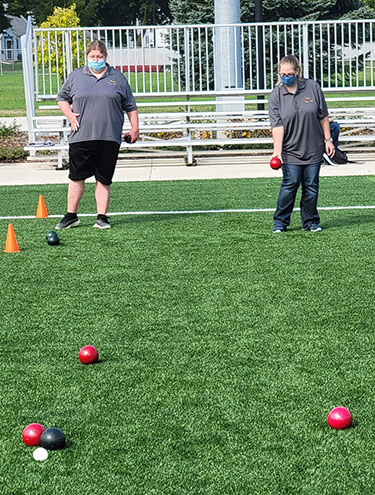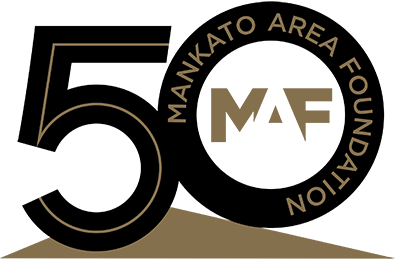
Community Impact
Giving Outside the Box
When the COVID-19 pandemic reached the Mankato area, local nonprofits felt its effects immediately. Programs shut down, government funding was shifted or cut, and the uncertainty forced many nonprofits to question their future and how best to serve their constituents.
“It was an incredibly difficult time for everyone in the area, and nonprofits were hit hard,” Mankato Area Foundation (MAF) President and CEO Nancy Zallek said. “As a community foundation, we knew it was our role to help support our partners through the unknown.”
In March of 2020, the Foundation partnered with the Greater Mankato Area United Way (GMAUW) to rally behind these organizations by creating the Community Response Fund, a central fundraising and granting platform designed to support local nonprofits in need. Organizations applied for funds through a single, simplified system, which meant MAF and GMAUW could easily learn about the needs of the community and respond to that need in a timely manner.
“Through the Community Response Fund, we quickly learned that local organizations serving people with disabilities were struggling, and they were struggling in similar ways,” Zallek said. “Through our conversations with these partners, we saw an opportunity to think outside the box to address the issues they faced.”
Zallek put her head together with Sarah Beiswanger, MAF's Community Grants and Nonprofits Specialist, and the two came up with a unique solution.
“We thought, ‘What if we used money from the Community Response Fund to pay for a nonprofit consultant to help these organizations discuss and achieve their collaborative goals?’” Zallek said. “We had never heard of another foundation doing anything like this before, but we were living through unprecedented times. Why not provide unprecedented solutions?”
After receiving enthusiastic support from GMAUW, Beiswanger and Zallek met with the leaders of MRCI, Leisure Education for Exceptional People (LEEP), Southern Minnesota Independent Living Enterprises & Services (SMILES), and the Miracle League of North Mankato to determine if these organizations would be interested in such an idea.
“Everyone we talked to was excited about this approach,” Beiswanger said. “It’s not often they are provided an opportunity to work with a nonprofit strategist, and this benefit is rarely in an organization’s budget.”
Zallek had worked with Kim Snyder, nonprofit consultant and founder of Excelsior Bay Group, for over ten years on a variety of projects with MAF, so Zallek knew she would be an excellent fit for the project. According to Snyder, the idea was instantly intriguing.
“I thought this was the opportunity of a lifetime,” Snyder said. “The Foundation clearly recognized these organizations as critical to the fabric of the community, and paying to help them collaborate was such a unique and wonderful idea. There was no doubt it would provide layers of benefit.”
Snyder, who has a background in fundraising and strategic planning, met with the group of nonprofit leaders in November 2020 to determine their shared needs and goals.
“We were charged with identifying a vision for serving the disability community throughout the pandemic and when we emerge from it,” Snyder said. “Our primary question was, ‘How can we do more with what we already have in this sector? How can we leverage each other’s assets to accomplish more?’”
According to Snyder, the group identified a shared vision, goals, and outcomes for the disability community, all of which focused on prioritizing quality of life for those living with disabilities.
“These leaders made it abundantly clear that quality of life is not always front and center for the people they serve,” Snyder said. “The strict systems, processes, and funding rules in place, which were designed to minimize risk and liability, have created organization-centric systems as opposed to person-centric systems. The belief of the group was that quality of life should be equally, if not more, important than things like safety and risk reduction.”
According to Lisa Wojcik, executive director of LEEP, the drastic services changes that resulted when COVID-19 hit were unimaginable.
“This opportunity enabled us to make it a priority to have important conversations about the impact on people with disabilities and what we could collectively do about it in a changed world,” Wojcik said. “Kim’s expertise was instrumental in leading our conversations and planning for the future. We would not be nearly this far without Kim and the funding provided by the Community Response Fund.”
Through the development of this shared vision, LEEP, SMILES, MRCI and the Miracle League created multiple long-term shared goals. These include coordinating recreation and leisure services for the people they serve and building awareness within the community regarding inclusion as a key to improved quality of life for people with disabilities.
“We needed to be innovative in order to address the needs of those we serve,” said Tami Reuter, chief business and marketing officer of MRCI. “It was a goal to streamline our processes, and in doing so, we came up with some unique ideas through this collaborative effort.”
As a Twin Cities resident, Snyder has long admired the way the Mankato community rallies around such goals, and she firmly believes this group of nonprofit leaders will be able to accomplish what it desires.
“Mankato is an innovative community,” Snyder said. “People get things done there. If this group says that 8% of the population is disabled and living on the margins, people will listen and do something about it. I have no doubt about that.”
According to Snyder, people are already taking notice. Snyder and her team have partnered with Minnesota State University, Mankato’s social work program and department of education to pair undergraduate interns and volunteers with these disability organizations as part of their graduation requirements. The coalition will create a single intake and vetting process, curate the service-learning experiences, and determine how and where the students could best serve each semester. The university faculty will then help match students according to their interests and skillsets.
“A solution like this is so exciting because it has so many areas of benefit for multiple parties,” Snyder said. “The students need to meet their graduation requirements and think about inclusion in real and critical ways, the organizations need reliable volunteers, and the individuals being served need high-quality experiences."
According to Zallek, such outcomes are a meaningful result of the Community Response Fund.
“When people donated to the Community Response Fund, they probably envisioned those dollars going toward band-aid approaches to immediate problems, which in some cases was true—but so much more has come of it than that,” Zallek said. “By funding a nonprofit consultant to collaborate with multiple organizations and institutions in the area, we have turned a few dollars into decades of benefit for our community.”
Snyder says this open-minded, innovative attitude toward charitable giving is what makes it so fun to work with Zallek and MAF.
“One of the things I love most about the Foundation and their approach to philanthropy is that they truly see themselves as partners to the nonprofits in the community,” Snyder said. “They never tell people what to do; instead, they are always asking, ‘How do we make our community better? How can we make things easier for our partners?’”
Snyder says she is proud to be part of such a unique venture.
“Getting nonprofits together to collaborate takes time and money, and it’s rarely something they can do on their own. They have enough going on!” Snyder said. “The Foundation knew this, and because they aren’t afraid of taking risks or doing things differently, they decided to try something new. And so many people are going to benefit because of their creative approach to philanthropy.”
